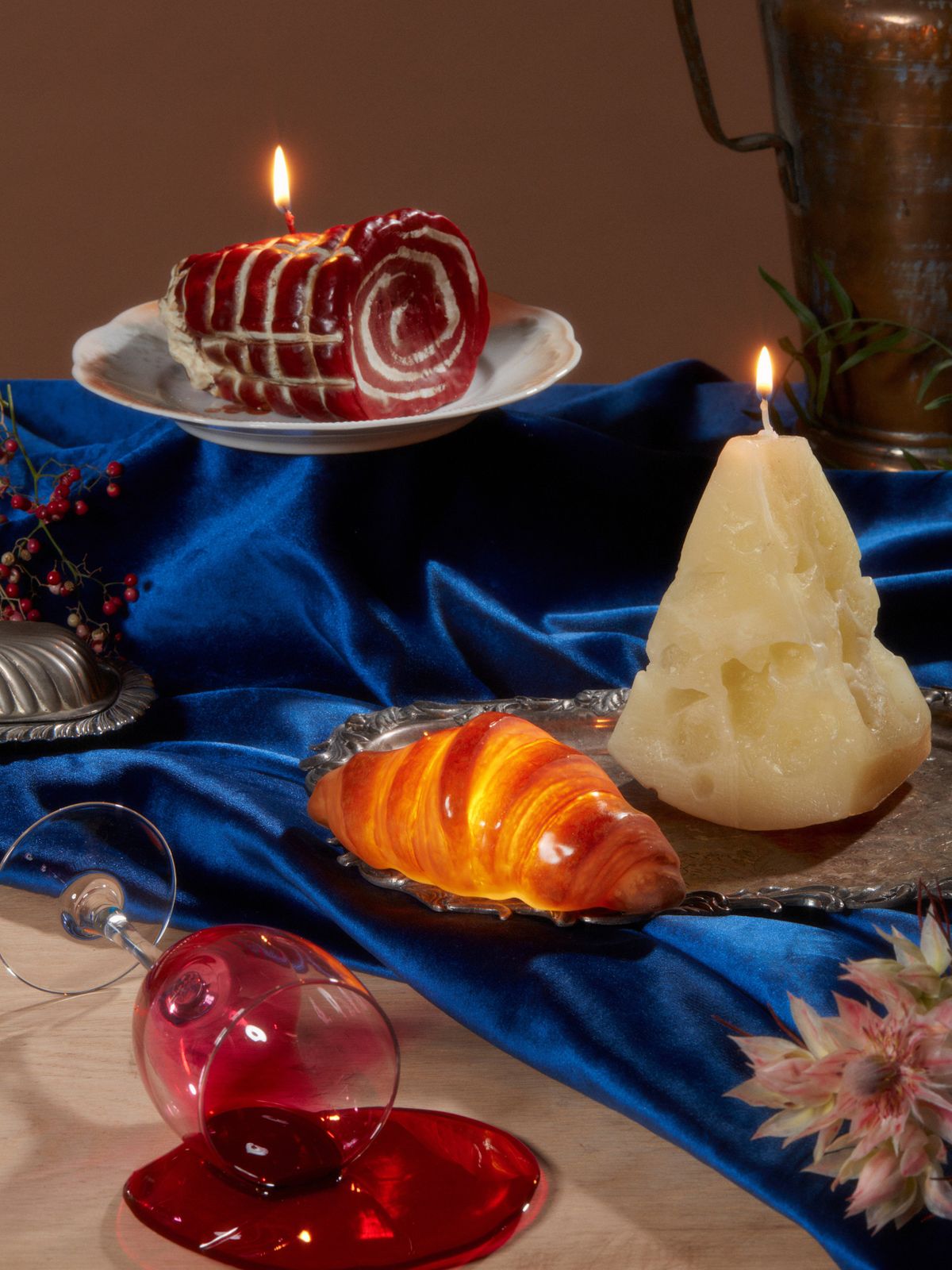Fake food is trendy again

Although a minimalist interior may have represented an aspirational environment only a few years ago, it seems that intermittent lockdowns and supply chain-induced shortages have led people to re-evaluate the aesthetic of an empty house.
The result is a resurgence of maximalist home decor that embraces pattern, color and ornamentation. Cabinetry that may once have been wood grain is now jewel-toned; streamlined furniture has given way to all things squishy and wiggly; trends such as “cottagecore” and “grandmillennial” aim to elevate items that are handmade, chintzy and secondhand.
Is it any wonder that fake food is back, too?
Charcuterie and cheese candles, resin-cast croissants and Jell-O salad lamps are hot items. Retro-style fake cakes are big on Instagram. The high-end jewelry brand Mociun sells faux glasses of spilled wine and melting ice cream cones alongside $10,000 engagement rings. And Yukiko Morita’s Pampshade lamps, which are made from real baked goods that have been preserved, can sell for around $80 apiece.
For John Derian, founder of an eponymous home decor and decoupage line, the resurgence of fake food is very welcome. Derian has had a fake cake sitting on his kitchen counter for 14 years, he said, and he estimates that he has been selling food-themed items in his store for about 20 years, starting with a stuffed doll made by Nathalie Lete that had sausages for arms and a steak for a head.
“I do love funny things,” he said.
These days, Derian also offers more elegant fake food items for customers who are less interested in kitsch, including stone bananas and cherries carved in Tuscany, Italy, using marble from the same quarry that Michaelangelo favored.
Derian often displays the paraffin wax beauties – which include doughnuts, cakes and pies – in the window of his shop.
“Everyone responds to them with joy,” he said.
A question of taste
Fake food has been used for decoration for centuries. Trompe l’oeil porcelain, made in 18th-century Europe, often took the form of fruit and vegetables, including melons and peas in a pod. There are examples of plates of fruit made from jade and alabaster from the Qing dynasty in China.
In recent centuries, fake food has remained popular in more utilitarian settings. In Japan, fake food, or sampuru, is displayed in the windows of restaurants, and can cost hundreds of dollars for artisans to make. In the U.S., fake wedding cakes can help preserve a visual tradition of a layered confectionary, while helping to cut down on the price of the real cake.
But when it comes to fake food as objets d’art in the American home, Sarah Archer, a design and culture writer and the author of the 2019 book “The Midcentury Kitchen,” suggests looking back to the 1950s and 1960s, when fake food became a trend.
“Blown-glass fruit was super popular in the ’50s and ’60s, especially after World War II, when it was more affordable and kind of interesting or enticing for middle-class Americans to travel abroad to Italy,” Archer said recently. American tourists would return from their journeys with glass apples or pears as souvenirs.
For some of the artisans and brands that sell fake food today, the question of taste – or of questionable taste – is what drew them to the trend in the first place.
Leanne Rodriguez, an artist in Oakland, California, who goes by Elrod, began making fake gelatin salad lamps during the pandemic. In a recent interview, Rodriguez said she wanted the effect “to be a little on the disgusting side.”
Using recipes for gelatin salads from midcentury cookbooks as inspiration, Rodriguez suspends hot dogs, vegetables and chopped fruit made out of clay in sparkly resin. Her creations, which she has branded Mexakitchen and sells as part of her Mexakitsch line of artwork, emanate an eerie glow from LED lights inside.
Rodriguez said a fascination with kitsch is what drew her to make the lamps in the first place, and the more she makes them, the more opulent they get.
“A lot of people don’t get it,” said Rodriguez, whose creations cost $100 to $3,500. “And the ones who do get it really love it.”
Cake race
The joy of fake food is something that Jazmine Rogers, a content creator in San Diego, recalls from her childhood.
Her grandmother had a collection of fake fruit, and when Rogers was decorating her own home, she made sure to seek out fake food pieces to display.
“There’s something about it that just feels really homey to me,” said Rogers, 25. “It’s kind of like playing with your food, it’s like your food’s in places that it’s not supposed to be. There’s something fun about it.”
Rogers’ fake cake was made by Jasmine Archie, an artist in Austin, Texas, who has been surprised and delighted by the market for her eccentric, color-saturated confectionary-inspired creations.
“People freaked out,” Archie, 25, said of the first few fake cakes she made. “It’s already on the market, but it was so untapped with my generation in my opinion. And I was like, ‘OK, I could totally market this and see what could happen.’ ”
According to Etsy, there has been a 36% increase in searches for faux cakes on the site in the past three months, compared with the same time the previous year.
Archer, the design and culture writer, said she thought that consumers were craving interior-design choices that were as comforting as they were whimsical.
Fake food is “a relatively inexpensive, easy and creative way to make your home joyfully wacky,” she said. “I definitely think that there is a desire for a sense of play.”
This article originally appeared in The New York Times.